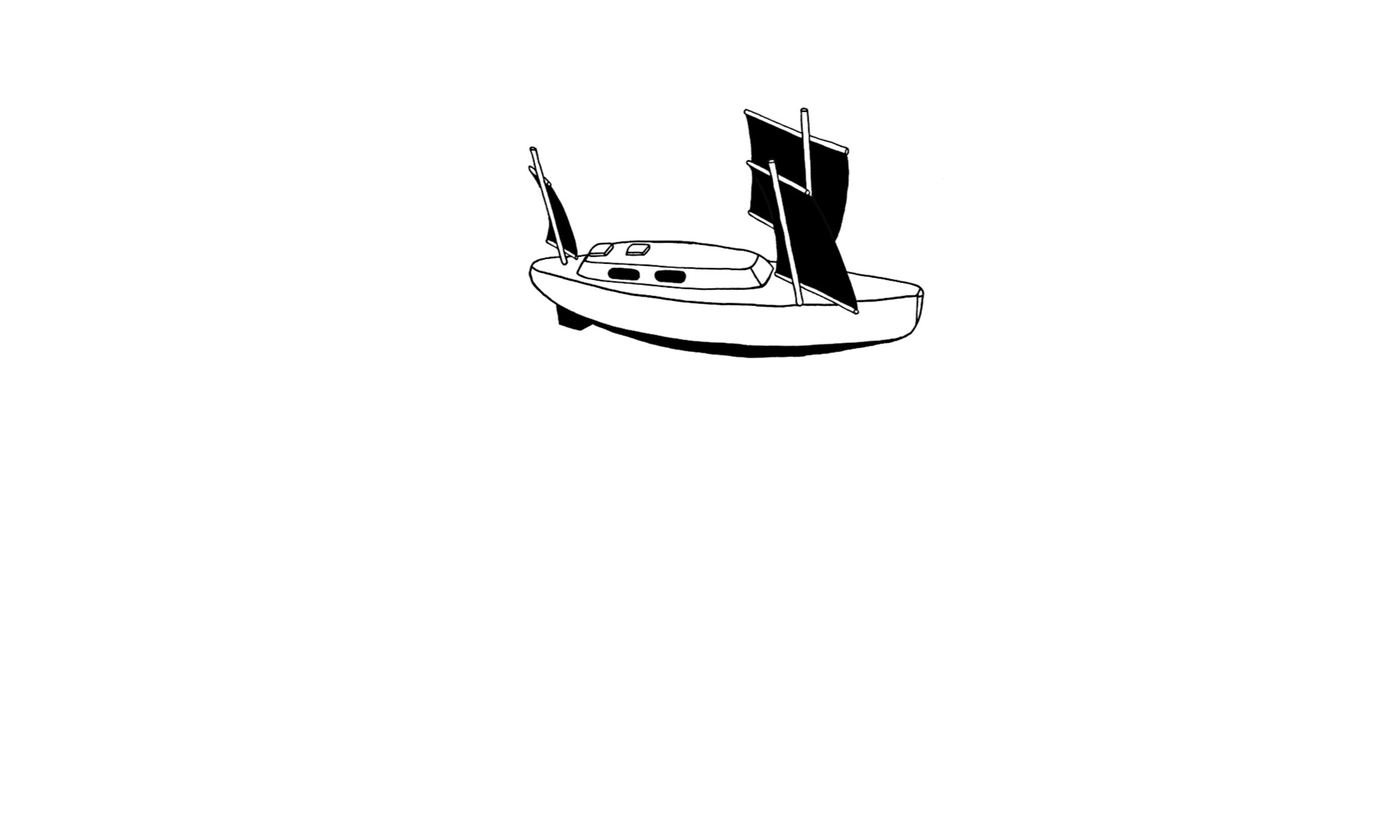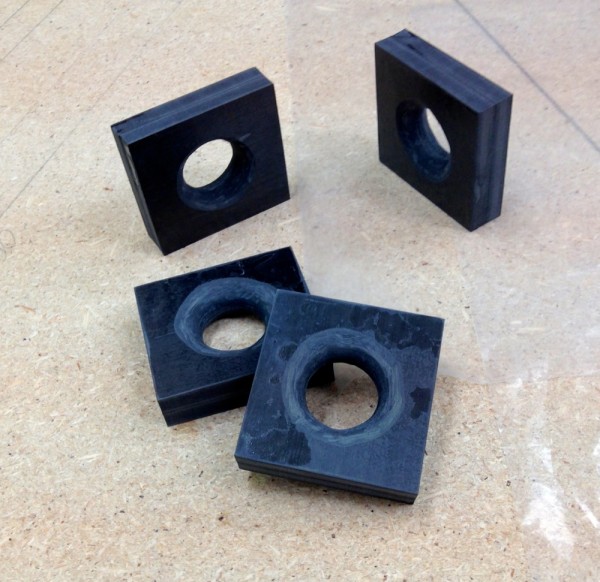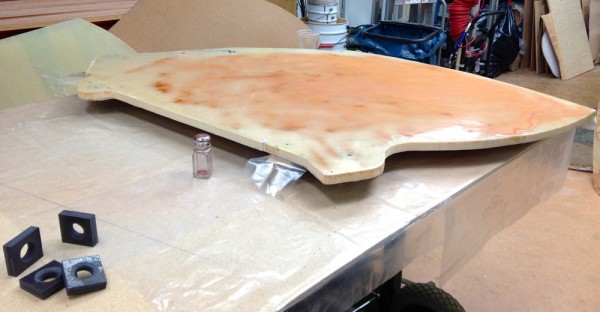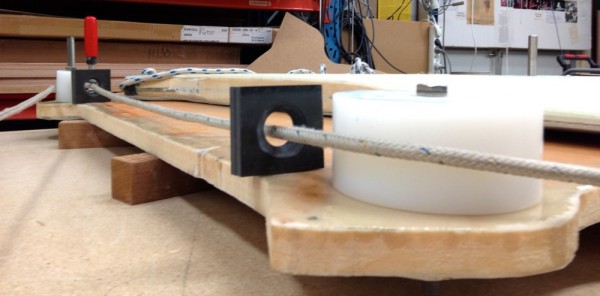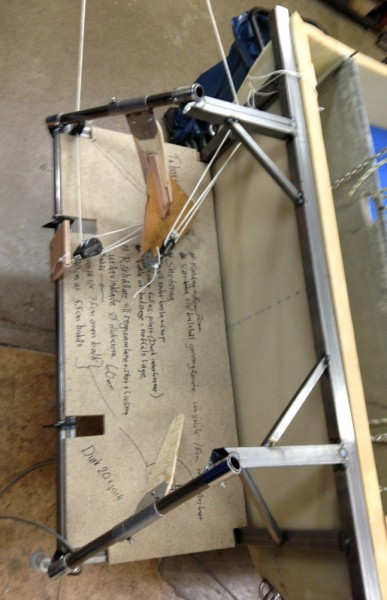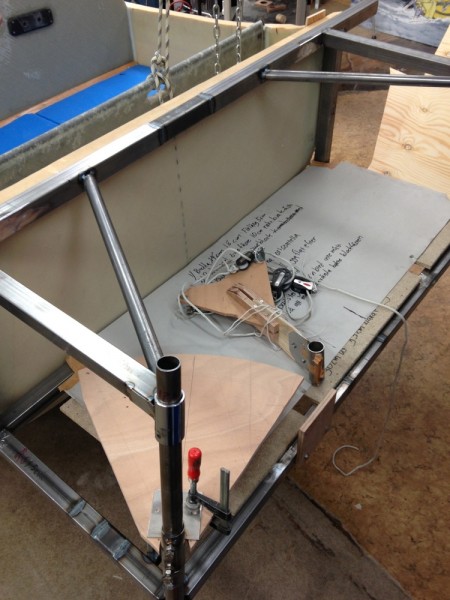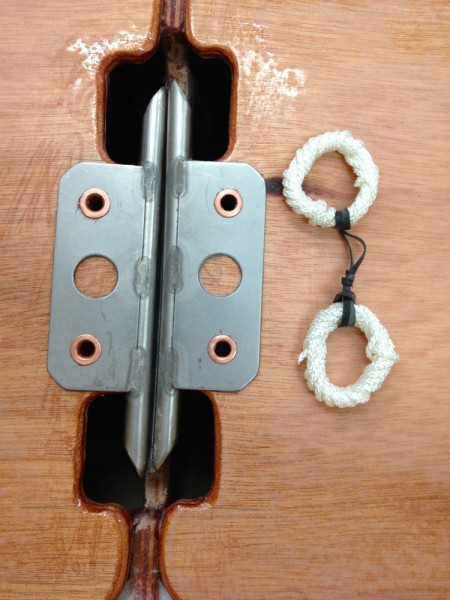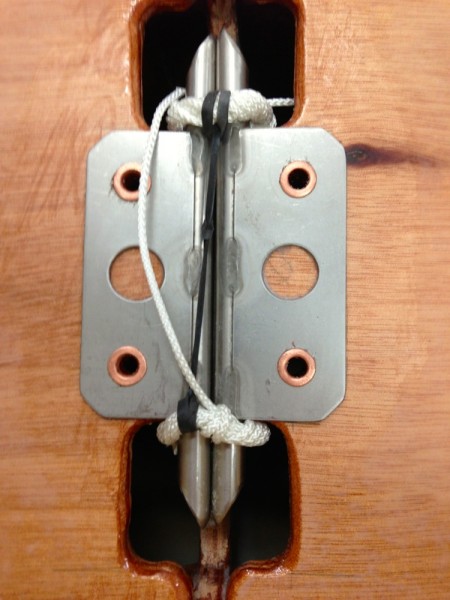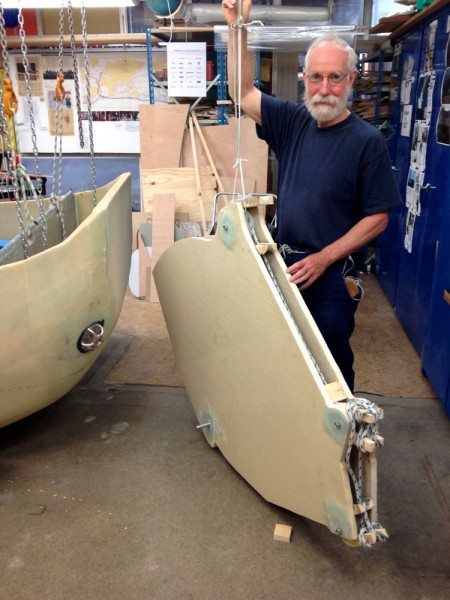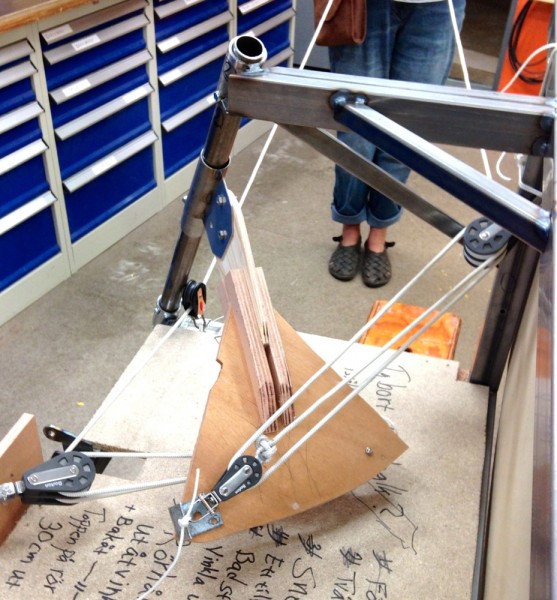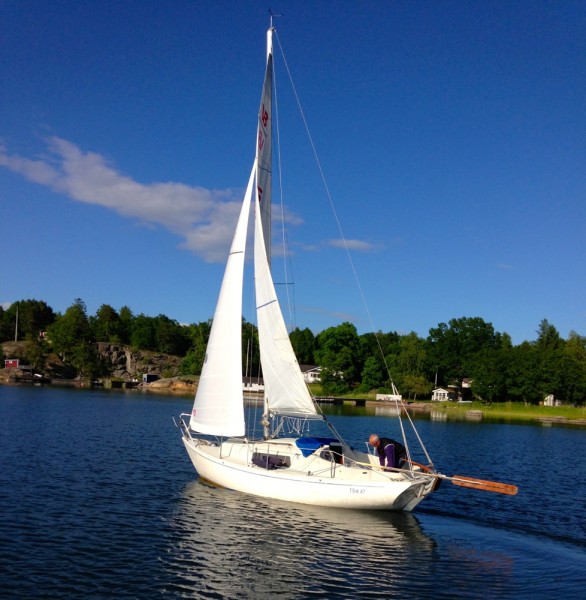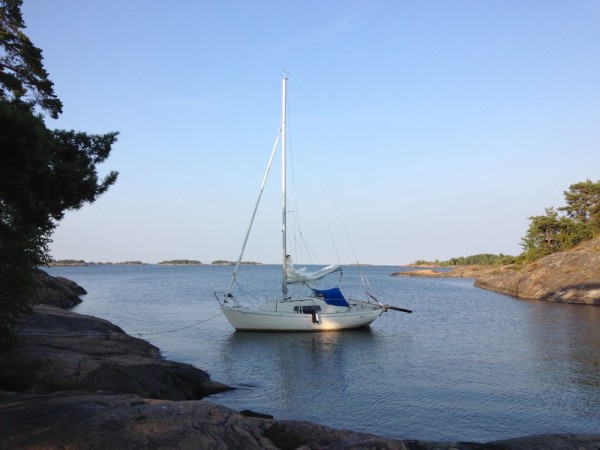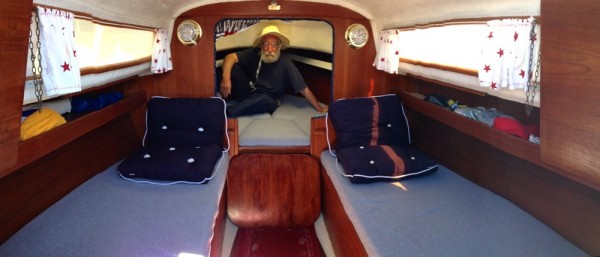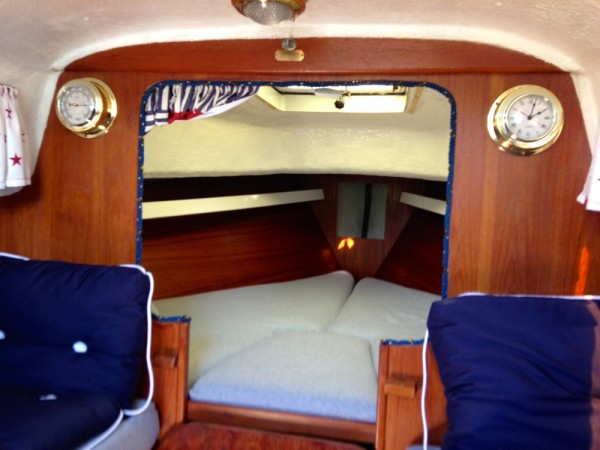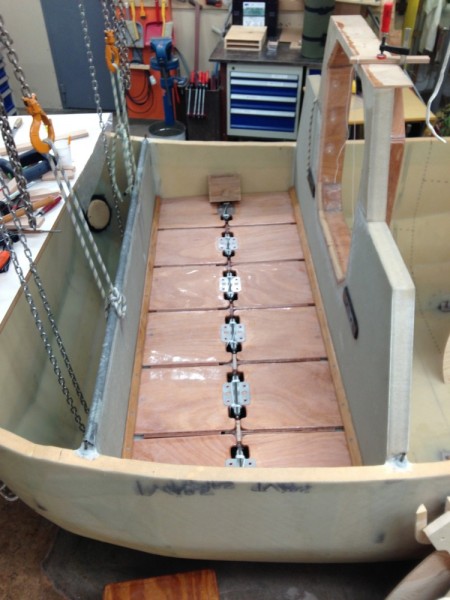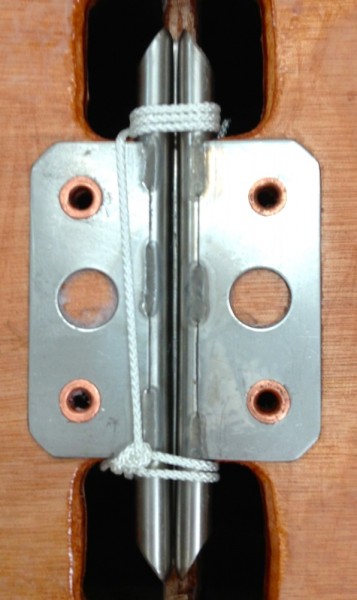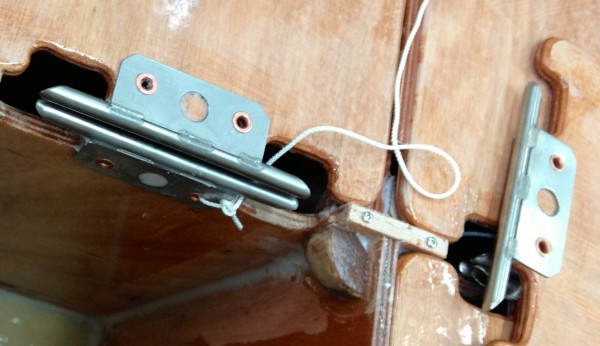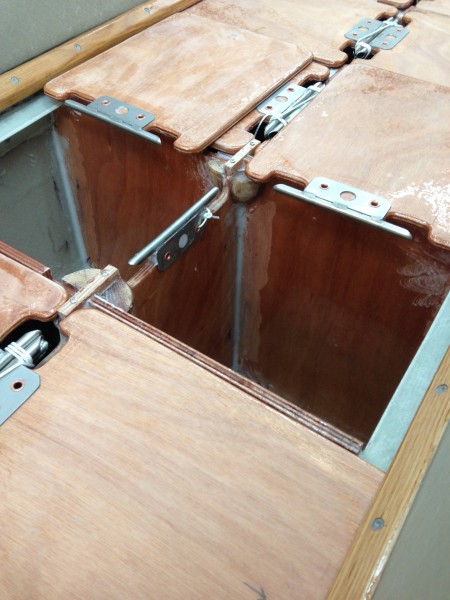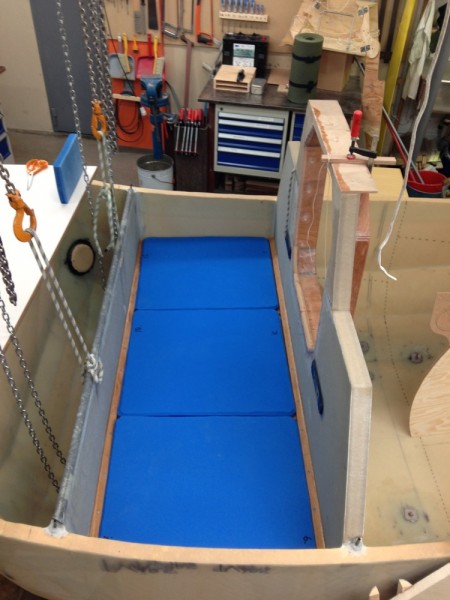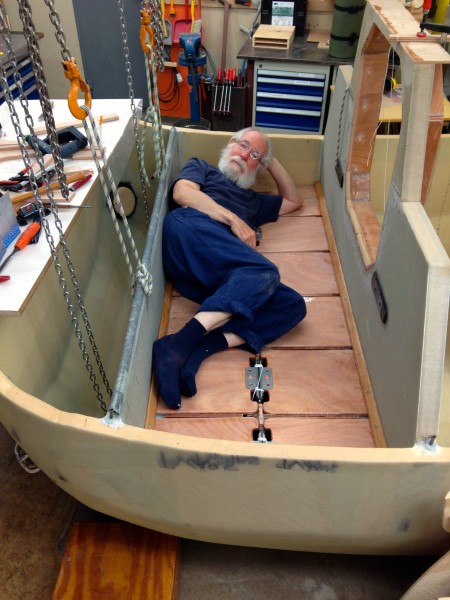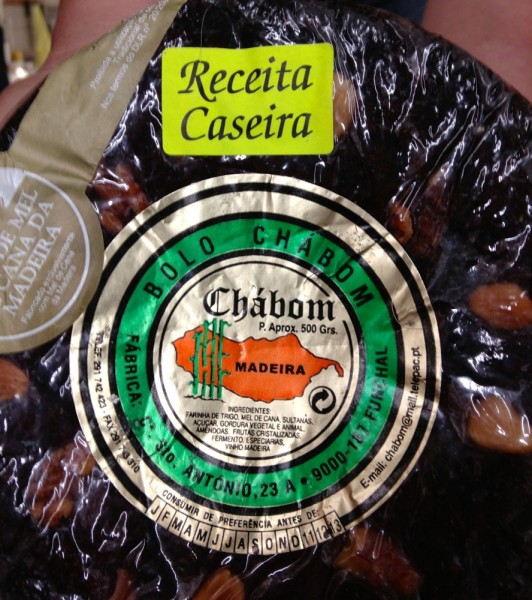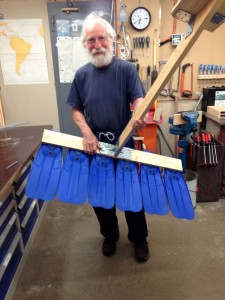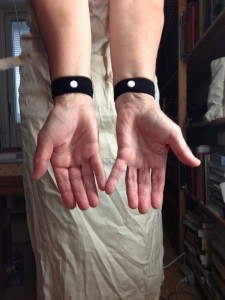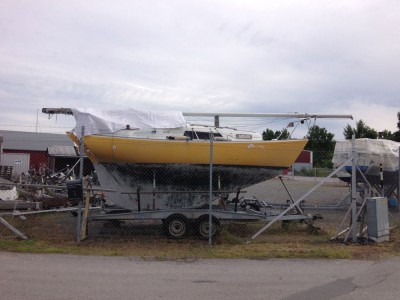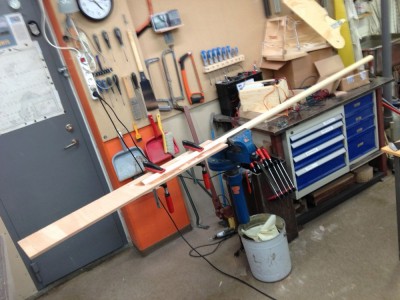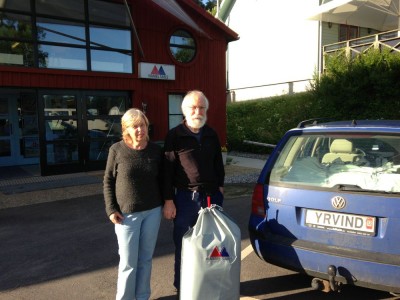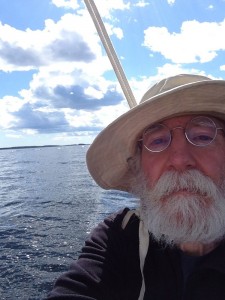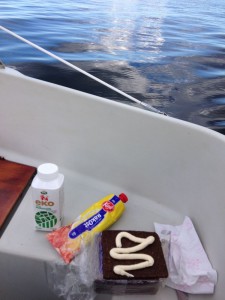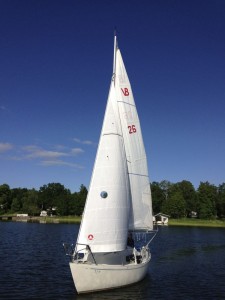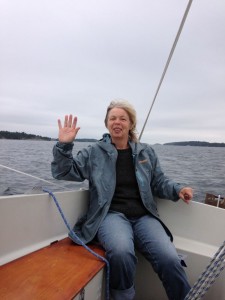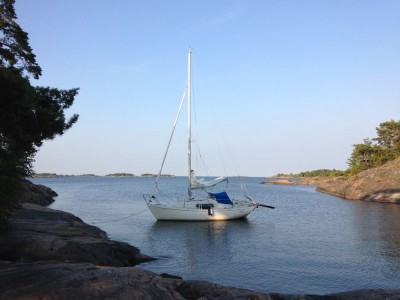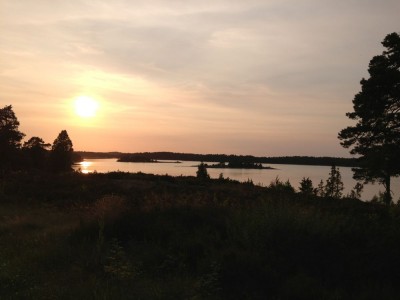The sound is a bit weak, please increase the volume on your computer.
Details
The idea of using ridges to guide the centerboards up and downhaul did not work to my satisfaction.
The new aproach is to use fairleads. I made up a few of carbon fibre. Click once or twice to enlarge.
Before I glued them on to the centerboard case I dusted the surface with cupper powder using a salt shaker. The purpose is to reduce marine growth and to make the surface a bit more wear resistance.
Below is the fairleads in place.
I will make new rollers with a hollow in them so that the line are keept in the middle and be less likely to jam. A jammed line is no good.
The rudder arrangement is now working to my outmost satisfaction. Only thing is the stainless steel structure is far to heavy. Therefore I will make a new one of composite surfaces, keeping the same geometry.
Once I had that thought I realised that the new structure can have the shape of a tank. A closed surface is strong.
The use of a tank way back is to fill it with saltwater running before gales. The yellow 15 feet boat I 2011 sailed with to Martinique had mowing ballast in form of lead. I could move them from side to side but also to the very back of the boat. It was a good idea.
It also struck me that in heavy rain I could collect extra water to do some washing when the sun later comes out.
Also it could cive some extra flotation. The platform is bolted on and therefore its lenght is not measured according to the harmonized standard of the EU:s Recreational Craft Directive, besides few things are more stupid than measuring a boat by lenght, or in fact any volyme by lenght except if they are of the same shape.
I take care to make the details good on this boat in order to have experience of them and use them on the next proper small boat.
To be continued…
Regards Yrvind.
TWO STEPS BACK.
The ropes in the centerboard did not run smothly so I am working on an other much better system. More about that later.
The rudder system is also being uppgraded. When I designed it I had in mind the boat sailing to windward healing 20 degrees so the rudder axis is 20 degrees out to compensate for that and also 20 degrees slope that they will not catch seeweed and other things . But – my rudders will also serve as brakes instead of a drouge. I just angle them outwards. Now I realised that that will give lift to the aft helping to pitch pole the boat.
The outward angle is now reduced to about ten degrees becouse that is better downwind and the aft to about 5 degrees. Tan for 5 and 0 degrees are nearly the same in this context. Of course it would be even better to angle them forward becouse that will suck the aft end of the boat down but that has to be balanced against catching things. It is a compromise.
Also I widened the platform 18 cm and lengtened her by 5 cm to enable me to have a longer tiller and so that the bathining ladder will not interfere with the line system.
The pictures below show before and after the change. The new line arrangement is not shown.
after change
To be continued…
Regards Yrvind.
MOVING ON
The hatches below the bed are now funtional. As a quicker alternative to the knot for closing and opening them. The pictures below show a gadget consisting of two textile eye loops connected with butyl rubber band.
The pictures below explain the function.
The textile eyes in place around the three cleats.
From hatches I have moved on to work with the center board. Below is a picture of the centerboard inside the centerboard case with its lifting and downhaul mecanism – it is not weighted and will have to be pushed down -. It is hanging in a string being weighted. Unfortunatly the scale did not fit into the photograph – well may be fortunatly because it is at 38 kilos a bit overweight.
Next step is to fine tune the mechanism to make it run smothly.
Janneke has been of great help the past month. Tomorrow she takes the bus back to Holland.
To be continued…
Regards Yrvind.
A LINE ARRANGEMENT FOR LARGE RUDDER ANGELS
When I scaled up the mock up of the steering arrangement from 1:2 to full scale 1:1 I realised I was on the wrong track. There where to much interference of the different functions.
One of the desirable properties of my version of the dubble rudder configuration is that I hope to be able to use it as a brake running before strong winds I therefore like to use large rudder angels.
There is also a swimming ladder and arrangement for a foil to be driven by wavepower. This has also to be taken into consideration.
Below is my latest solution. A tiller with lines did not give large enough rudder angels. A quadrant would give large enough angles but would require the steering lines to be in tension at all times otherwise they would jump out of their tracks.
My arrangement looks a bit like a quadrant but is not. It has blocks fastened on each side of rudderplane enabling me to get large angels. Also that takes upp the big forces as close as possible to their origens enabling me to have thinner lines.
Below are some pictures. They should be self explaining. Only one side is done on the mock up as the two sides now do not interfere with each other.
In the middle will be the bathing ladder. To make it wide enough I will widen the platform by 11 cm each side to get a total ladder width of 44 cm.
Click once or twice on the pictures to enlarge.
To be continued…
Regards Yrvind
SAILBOAT FOR SALE € 3.900
After a nice sailing holliday Janneke is going back to Holland, to her garden, violin and cat.
I have to return to my project Yrvind Ten so with sorrow in our hearts we are selling our beautiful Västbris.
She is good quality built on the island of Orust with teak interior and lead keel. She sails very well.
She has a new mainsail 2013 and a new rolling furling jib 2012. In addition there are also an older spinnacker, genua and mainsail in good condition.
The upholstery is new and she is generaly kept in nice clean condition.
She is a good alternative to an Vega for an exctended cruising for a person that wants a smaller boat.
She is 6.15 meter long, has a beam of 2.12 and a draft of 1.1 meter. Her displacement is 1.6 tons 50 % of that is in her full lenght lead keel.
Below are some pictures. Click once or twice to enlarge.
For more information call Yrvind at +46 70 620 05 50 If at once I do not ansver try again.
Regards Yrvind.
STORAGE UNDER THE BUNK
The storage under the bunk is now done.
It is about 600 liters space. Well packed with food and books there is a lot of weight that I do not want to get adrift when the boat is thrown around in strong winds. Therefore the plywood pieces that subdivide the space is is well anchored with fillets and glass fibre taping in NM-epoxi. About 50 meters.
The locking system consists of 3 cleats and a string. No mowing parts and the string can easily and cheaply be replaced anywhere and under any conditions. A strong and pretty foolproof system.
Below are some pictures to facilate an understanding of this new system.
Click once or twice to enlarge the pictures.
The twelve hatches that makes the bed
The three cleats and the string.
One hatch is opend
Two hatches are opened
The bed with mattrass. The foom has closed cells and can therefore not take up water.
A happy me in the bed
And then as a final treat a gateau bought in Madeira 2011 for my trip to Martinique. I now found it two years old in prime condition. It tasted excellent. I will for sure bring plenty of them for the coming trip
To be continued…
Regards Yrvind.
WAVE PROPULSION
The last stretch of our sailing was in the open sea a day after a gale. In the evening the wind died and the rocks reflected the waves created by the waves. The boat was rocking a lot. As we wanted to get back to Västervik I used the sculling oar for hours. I had had a simular excperience 2011 when coming in to Porto Santo Madeira. Then I sculled for ten hours rolling badly.
The Idea I got was to use wave power to propel the boat. It is an old Idea. Whalers were mystified to see dead whales floating on the surface making speed through the water. Some of them cut of whalefins and nailed them under their boats and made speed. It were the waves that powered them.
I have written about this before and done some experiments. Below is a picture of a rude contraption made of six swimming fins and some wood.
If it propels me at 1.5 knots the same speed as my oar, I will be happy. I hope weather conditions soon will allow me to make a test. Click once or twice on the picture to enlarge.
To be continued…
Regards Yrvind
HOW TO PREVENT SEASICKNESS
During our years of sailing in the seventies Janneke always suffered terrible from seasickness. Now there is a cure based on the chinese acupressure method. After our nice holliday sail Janneke wishes to make the following statement.
Before I met Sven I had no sailing experience at all.
So when sailing on Bris for the first time I discovered that I was one of those people suffering seasickness. I did not take it too serious so I came on board to cross the Atlantic Ocean and round Cape Horn. I did suffer severe seasickness for three weeks. I could not eat or drink anything and eventually I fainted.
At last my body got used to the movements of the sea that I could eat enough to survive.
Now many years later with our Västbris, I was quit worried as you may understand. Sven had heard about Seaband and bought a pair for me, it might help, who knows.
Well it sure did !!!
I did not feel seasick at all, not even at sea the day after a storm with high waves and a rolling boat, I was feeling just fine.
So now I know what to wear being at sea.
Janneke Schokker
Regards Yrvind
A SAILING HOLLIDAY
Janneke from Holland sailed with me in the first Bris 1972 to 1978.
Recently we have renewed our contacts.
A few weeks ago Janneke suggested that as small sailboats are so cheap in Sweden and as it such a paradise to cruise here why do we not purchase a little boat and have a holliday.
After searching the web we chose a Västbris 20. A high quality boat with lead keel and teak interior.
Below a picture of a sister boat on land
We bought an boat without an engine so i made a sculling oar. Here is the start.
My trusted sailmaker Hans Hamel made a new mainsail
I took delivery of the boat in Stockholm and sailed her to Kopparmora båtklubb where Beppe my webmaster looked after her her while I drove to Holland to pick up Janneke. Below a selfportrait
My first meal abord consisted of Räkost and raybread and milk. The raybread was leftover from my 2011 Atlantic crossing in the 4,8 meter chinerunner. It tasted as good as new and is probably good for a few more years.
Webmaster testing the boat with the old mainsail.
Janneke at the tiller.
Tied up to an island near Oxelösund.
Below, a few islands near Fyrudden Gryt. There are tens of thousands of unhibited island in that region and no tide, a paradise.
Now we are back in Västervik working.
Janneke has promised to write something about how Seaband and akupressure prevents the terrible seasickness.
To be continued…
Regards Yrvind
